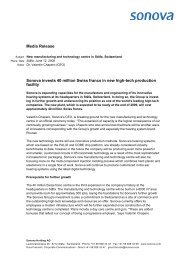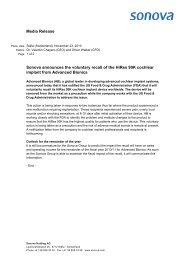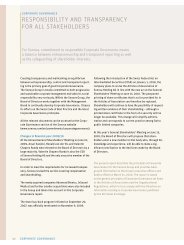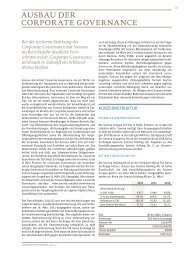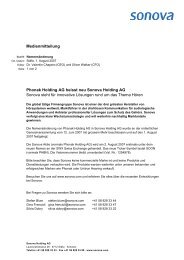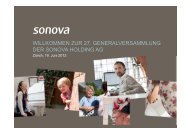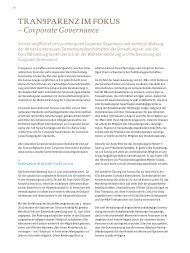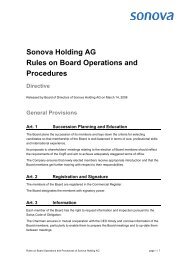Annual Report 2010/11 - Sonova
Annual Report 2010/11 - Sonova
Annual Report 2010/11 - Sonova
You also want an ePaper? Increase the reach of your titles
YUMPU automatically turns print PDFs into web optimized ePapers that Google loves.
8<br />
TYPES OF HEARING LOSS<br />
In a healthy ear sound is received in the outer ear by the<br />
pinna and conducted into the ear canal. The sound waves<br />
cause the ear drum to vibrate. These vibrations are amplified<br />
twenty times by three tiny bones in the middle ear –<br />
the malleus, incus and stapes – and transmitted to the opening<br />
of the cochlea (inner ear). This sets the fluid inside<br />
the cochlea in motion. The waves produced stimulate the<br />
approximately 3,500 outer and 10,000 inner hair cells<br />
and are transformed by these into electric signals. These<br />
signals are sent by the auditory nerve to the brain’s<br />
hearing center, where they are decoded and interpreted<br />
as sound.<br />
Various adverse effects on this process can result in hearing<br />
impairment. The cause of hearing loss may lie in the outer,<br />
middle, or inner ear; in the auditory nerve; or in the brain.<br />
Possible causes include exposure of the ear to very loud<br />
sounds (e. g. acoustic trauma or noise), poisoning, infectious<br />
diseases, injuries to the ear, or hereditary diseases.<br />
Age-related hearing impairment (presbycusis) is the most<br />
frequent cause of hearing loss. Hearing begins to decrease<br />
gradually once a person reaches age 30. It is primarily<br />
the hair cells, which are important for high-frequency sounds<br />
and thus for speech intelligibility, that degenerate with<br />
increasing age. More than 50% of people over the age of 70<br />
are hard of hearing.<br />
Cochlear implants<br />
Cochlear implants are a medical solution for sensorineural<br />
hearing loss ranging from severe hearing impairment to<br />
complete deafness. They electrically stimulate the auditory<br />
nerve. <strong>Sonova</strong> develops and distributes cochlear implants<br />
under the Advanced Bionics brand.<br />
Direct acoustic cochlear stimulation (DACS)<br />
The DACS middle ear implant is suitable for mixed and moderate<br />
to severe hearing loss. Phonak Acoustic Implants is<br />
developing a middle ear implant that can directly stimulate<br />
an intact cochlea by mechanical means.<br />
Hearing protection<br />
More and more people need some type of hearing protection<br />
– either standard models or a customized solution –<br />
in the professional domain that will ensure that their hearing<br />
is protected in noisy work environments. <strong>Sonova</strong> manufactures<br />
and markets hearing protection solutions under<br />
the Phonak Communications brand.<br />
Communication and FM solutions<br />
Wireless communication and FM solutions are today utilized<br />
in many different ways: for better acoustics in theaters,<br />
to facilitate better understanding in school environments<br />
and meeting rooms, or for communication across greater<br />
distances. People with or without hearing loss can benefit<br />
from FM solutions that transmit speech directly to the ear<br />
by radio waves and block out background noise. Phonak<br />
Communications serves this market with a broad range of<br />
solutions.<br />
ACHIEVING SUCCESS THROUGH WELL-DEFINED<br />
CORE COMPETENCIES<br />
<strong>Sonova</strong> stands for innovative hearing care solutions. With<br />
more than 60 years of experience in hearing technology<br />
and the most comprehensive product portfolio in the business,<br />
the <strong>Sonova</strong> Group is extremely well positioned to<br />
continue to expand its leading role and to profit to an even<br />
greater degree from the trends in this growth industry.<br />
Innovation, a strong global presence and a clear customer<br />
focus are the main pillars of <strong>Sonova</strong>’s sustainable growth<br />
strategy. Strong core competencies form the foundation for<br />
the current and future success of the <strong>Sonova</strong> Group and<br />
its brands. A strong research and development program,<br />
leading-edge production facilities, innovative marketing,




